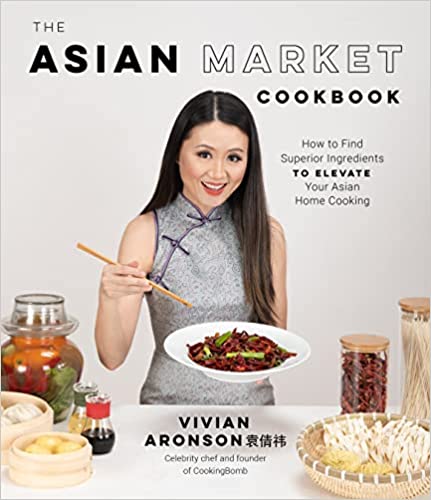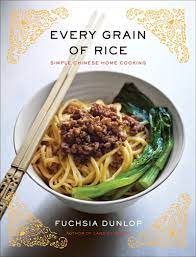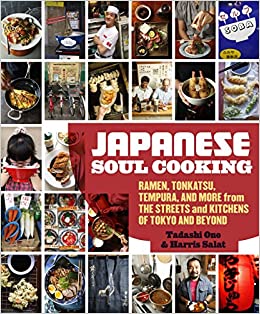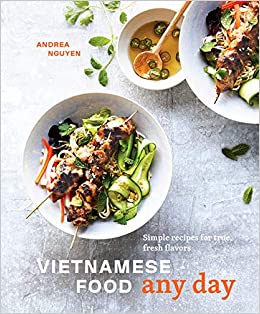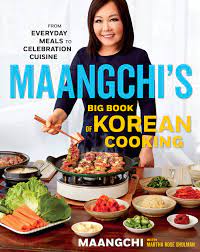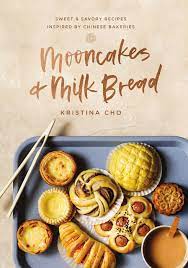Best Asian Cookbook
There’s something about Asian cooking that starts the taste buds tingling. It could be the dazzling mix of flavors, seasonings, textures and cooking methods, or it could be the wide range of dietary preferences it can accommodate, from vegan and vegetarian to carnivore and pescatarian. Satisfying your craving for Asian cuisine is as easy as choosing the right Asian cookbook — or two.
There are a wide selection of Asian cultures, culinary traditions and cooking methods, from East Asia with Chinese, Korean and Japanese food, Southeast Asia with food from Vietnam and Thailand as well as southeast Asia with food from India. While many of these cuisines use similar spices and cooking methods, the specific regional touches add their own unique taste.
To start you on your cooking adventures, we’ve collected a list of some of the best Asian cookbooks you can purchase online. Hard cover, soft cover or kindle, we know you will find something to inspire your inner foodie.
1. Editor’s Choice: 101 Asian Dishes You Need to Cook Before You Die
If you’ve never heard of Jet Tila, you may want to look him up. Or we can save you the trouble. Tila is a chef and media personality with a Chinese/Thai background who has French and Japanese culinary school training and is a chef partner in three Thai restaurants.
Tila uses the Yum philosophy of Asian kitchens, a Thai word that he says translates to the “perfect balance between spicy, sour, salty, sweet and savory” a good principle to remember when cooking Asian food. The book begins with notes on shopping and ingredients, so if you don’t know the difference between chili garlic sauce and sambal oelek or the best fish sauce to buy, he’s got you covered.
And when it comes to diversity in recipes, well, with 101 of them, it hits all the areas. From Indian nan bread and a Vietnamese Bahn Mi sandwich to Pad Thai (last recipe you will ever need) and Korean BBQ short ribs, your taste buds will be dancing. To make the book easy to navigate, he lists the recipes according to region. This is a good choice for beginner chefs,, but if you are looking for anything over and above regular fare, you may want to pass.
Pros:
- Available in kindle, paperback and spiral-bound
- Wide assortment of recipes from different regions
- Beautifully styled food photos
- Ideal for beginners
Cons:
- Measurement equivalencies from cups to grams are inaccurate
- Photos don’t always resemble the actual outcome of the recipes
2. Runner Up: The Asian Market Cookbook
Have you ever gone shopping in an Asian grocery store and stood staring at the shelves not knowing which sauce or type of rice to buy because all the descriptive information on the packaging is in Chinese? Author Vivian Aronson (Yuan Qian Yi) was born in Chendgu, China, the capital of Sichuan Province and came to the United States in 2005. She says she created this cookbook for the novice chef who wants to use authentic ingredients in Asian cooking but has no idea where to start.
Aronson devotes the pages of her book to walking you down the aisles of your local Asian market to select the tastiest sauces, condiments, spices, noodles, and rice to demystify the experience and empower you with confidence. Along with the familiar miso paste and sesame oil, you will also discover fermented tofu, Sichuan fermented broad bean chili paste, potato noodles and preserved mustard stems.
Drawing from her childhood experiences of when she was sent to the market to buy vegetables, soy sauce and other cooking ingredients for the daily meals that were created at home, Aronson includes 60 recipes that include miso salmon, double-cooked pork belly and phoenix tail in sesame paste (hint, this is really a salad).
Pros:
- Easy to read, user-friendly
- Demystifies ingredients
- Good food photography
Cons:
- Not a lot of recipes
3. Best for Budgets: Every Grain of Rice: Simple Chinese Home Cooking
It’s no secret to anyone how expensive food is becoming, with grocery bills skyrocketing despite all efforts at being frugal. If you love Asian food and are looking to create delicious and cost-effective meals, then you may want to check out this cookbook.
Author Fuchsia Dunlop trained as a chef in China’s leading Sichuan cooking school and says her goal in creating the cookbook was to “Make vegetables taste divine with very little expense or effort, and how to make meat go a long way.” In fact, two-thirds of the recipes are completely vegetarian or can easily be adapted as so.
The majority of the recipes come from the Sichuan, Hunan and southern Yangtze regions, while there are a few from Hong Kong, Guangdong and Fujian. Dunlop has included non-complicated recipes as well as details on ingredients, cutting and chopping techniques, kitchen equipment and different cooking techniques. Sample recipes include everything from everyday stir-fry chicken and Hangzhous breakfast noodles to braised pork with potatoes and smacked cucumber in garlicky sauce.
Pros:
- Information on kitchen equipment, cutting techniques and ingredients
- 150 easy-to-follow recipes
- Beautiful food photography with each recipe
Cons:
- Only available in kindle and hard cover
- Some of the fresh Asian produce and ingredients may not be available in all parts of the US
4. Best Japanese Comfort Food: Japanese Soul Cooking: Ramen, Tonkatsu, Tempura, and More from the Streets and Kitchens of Tokyo and Beyond
What do you think about when someone mentions Japanese food? Sushi? Sukiyaki? Udon? Does soul cooking or comfort food ever come to mind? Taking a step out of traditional Japanese fare, cookbook authors Tadashi Ono and Harris Salat offer up a brief history of Japanese cuisine and the infiltration of Western culture that developed into comfort food they describe as “hearty, flavor-packed, craveable dishes you’ll find in every kitchen and street corner hole-in-the-wall restaurant in Japan.”
In this photo-heavy, 256-page cookbook, you’ll find a collection of more than 100 recipes that explores new ingredients, techniques, and foods such as curry, tonkatsu, and furai, as well as soba, udon, tempura and the origins of popular dishes like gyoza and tempura. Some of the more intriguing and lesser-known recipes include Japanese classics such as wafu pasta (spaghetti with toppings like miso meat sauce), tatsuta-age (fried chicken marinated in garlic, ginger, and other Japanese seasonings), savory omelets with crabmeat and shiitake mushrooms, chahan fried rice, mentaiko spaghetti, and saikoro steak. If you want to learn how to make raman, you will find this book helpful as well.
Pros:
- Introduces new foods
- Beautiful photography
- Well organized
Cons:
- Not many vegetarian or seafood recipes
- Some ingredients may be difficult to find locally
5. Best Vietnamese-American: Vietnamese Food Any Day: Simple Recipes for True, Fresh Flavors
Some Asian cookbooks are so authentic, the recipes include many ingredients native to that country. So, while you may want to try your hand at re-creating a special dish, depending on where you live in the United States, you may not be able to find some of the more unusual ingredients.
When Vietnamese cookbook author Andrea Nguyen came to America with her family in 1975, it was difficult for her mother to find the foods she was used to cooking with in her homeland, and Nguyen grew up with a creative blend of both cooking styles. Fast forward to now, and the food landscape has changed so much, that many of those Vietnamese ingredients are staples in American grocery stores such as Whole Foods, Albertsons, Trader Joe’s, Publix and Giant Eagle.
Nguyen wrote the cookbook for chefs who want to make delicious, easy Vietnamese-inspired dishes using ingredients found close to home, every day — no Asian market shopping required. Through her thoughtful instructions and wide range of recipes, you will learn how to put together a Vietnamese meal and how to incorporate this form of cooking into your regime, all while using regular pots and pans (no wok or Chinese steamer is required), a pressure cooker, or a microwave.
Pros:
- Recipes are easy to adapt to American grocery stores
- Easy to follow instructions
- Gluten-free options
Cons:
- Not for anyone looking for authentic Vietnamese cuisine
- Not enough photos
6. Best Korean: Maangchi’s Big Book of Korean Cooking: From Everyday Meals to Celebration Cuisine
Korean barbecue is a popular way to enjoy this culture’s food, but there is more Korean cuisine than cooking pieces of raw meat over a grill on a table. It’s textured, varied and intensely flavored with pungent spices, with most dishes based on rice, vegetables, seafood and (in South Korea) meats, with little to no dairy, making it ideal for vegans, vegetarians and carnivores.
Emily Kim, commonly known as Maangchi, along with co-author and cooking teacher Martha Rose Shulman, weren’t kidding when they named their cookbook Maangchi’s Big Book of Korean Cooking. With 448 pages, it’s more than double the size of many other cookbooks out there. This translates into a truly inclusive array of Korean recipes and pertinent cooking information you need to delve into this centuries’-old cuisine.
The book contains a wide range of recipes, from different kimchi and fried chicken to bulgogi and bibimbap. It also explores the vegan fare of Buddhist mountain temples and the inventive snacks of street vendors. Bolstered by hundreds of beautiful color photos, a comprehensive guide of ingredients with photos and a detailed chapter on Korean cooking techniques, this book will take you from A to Z of delicious Korean cuisine.
Pros:
- Very informative
- Lots of detailed instructions with photos
- Includes party food, side plates, soups, hotpots, stews
Cons:
- Not available in soft cover
- Kindle version is more expensive than the hardcover
- Fewer photos in the kindle version
7. Best Vegan and Vegetarian: East: 120 Vegan and Vegetarian Recipes from Bangalore to Beijing
Eating a plant-based diet, or at least consuming less meat, chicken and fish, is becoming a popular dietary choice. Many Asian cultures emphasize rice, noodles and vegetables in their recipes, making this style of cuisine extremely vegan and vegetarian-friendly.
East, named one of the best cookbooks of the year by the New York Times, the Boston Globe, and Delish, delves into a wide range of Asian cuisines, from India to Indonesia, Singapore and Japan by way of China, Thailand and Vietnam. Author Meera Sodha’s offerings, inspired by the East Asian and Southeast Asian cooks and gourmet cooks she met and spoke with, include easy-to-make noodles, curries, rice dishes, tofu, salads, sides, and sweets.
Within the pages of this cookbook, you will learn how to whip up a root vegetable laksa and a chard, potato, and coconut curry and how to make kimchi pancakes, delicious dairy-free black dal and chili tofu. There are sweet potato momos for snacks and unexpected desserts like salted miso brownies and a no-churn Vietnamese coffee ice cream. A nice bonus in this book is a page with online suppliers to find hard-to-access ingredients such as spices, flours, vegan baking ingredients and Indian, Thai and Korean specialties.
Pros:
- Ideal for vegans and vegetarians
- 120 recipes
- Online resource list of ingredients and products
Cons:
- No softcover edition
- Not all recipes have photos
8. Best Baked Goods: Mooncakes and Milk Bread: Sweet and Savory Recipes Inspired by Chinese Bakeries
When you think about Chinese food, what probably comes to mind is what is typically found on a restaurant menu: chow mien, dim sun, cashew chicken and vegetable fried rice. But what about baked goods? If you’ve never walked into a Chinese bakery to experience the unique offerings on the shelves, then this cookbook will open your eyes and start you on a new culinary journey.
Food blogger and author Kristina Cho grew up surrounded by food (her family was in the restaurant business), but when it came to her formal education, she became an architect. She eventually moved away from designing buildings to creating the kinds of food she remembered loving in the Chinese bakeries she and her family frequented. The result is this remarkable compilation of sweet and savory baked buns, steamed buns, Chinese breads, unique cookies, whimsical cakes, juicy dumplings, Chinese breakfast dishes, and drinks.
The cookbook is organized in a way that reflects Cho’s architectural background, with clear, detailed explanations of ingredients and cooking methods, before leading into a wide range of recipes, from steamed BBQ pork buns and pineapple buns with a thick slice of butter, to milk bread and silky smooth milk tea.
Pros:
- Well organized
- Clearly written
- Detailed recipes with illustrations
Cons:
- A lot of reading and background
- Recipes do not indicate how long it takes to put together and cook times
What to look for when choosing an Asian cookbook:
Asian food differs greatly from region to region – Central, North, South, East and West Asian food has different characteristics, and each country has its own specialties. For example, rice is a common factor, but even rice changes throughout regions. Basmati rice is common in India while jasmine rice is more popular in Southeast Asia. Before choosing an Asian cookbook, do some research to discover the types of tastes, ingredients and flavors you are looking for. You can choose a cookbook that focuses on one specific region, or one that offers a broader range of options.
Ease of use: Some Asian recipes require many steps and a lot of ingredients, while others take less time and effort. Decide what kind of cook you are and then check out a few recipes. For a novice, if the list of ingredients is long and the instructions complicated, you may want to pass, no matter how mouth-watering the photos look.
Ingredients: This is an important factor to consider. Many Asian recipes contain ingredients that are native to that part of Asia and depending on where you live in the United States, you may not have access to some or even many essential ingredients. This is especially true for fresh produce, which may not be available for online ordering and delivery in a timely way.
Eating style: We all enjoy different kinds of food and follow different diet regimes. Vegan, carnivore, vegetarian, pescatarian, keto, paleo – the list is long. So, when it comes to an Asian cookbook, look for one that reflects your eating style, because when it comes down to it, it’s really all about the food.
That also includes the flavorings and spices, since this is a large part of Asian cooking. If you don’t like the ingredients or the recipes, if they are too spicy, you’re not going to use the cookbook. The best thing to do is to find an Asian cookbook that reflects your tastes with easy-to-follow steps, a reasonable amount of ingredients and colorful photographs to illustrate the final product to make your cooking experience more enjoyable. As well, the recipes should reflect your cooking style. If you are a busy cook on the run, you’ll want 15- or 30-minute prep options and less complicated recipes with no more than five ingredients.
Photo credit: Michal Hlavica/Shutterstock


